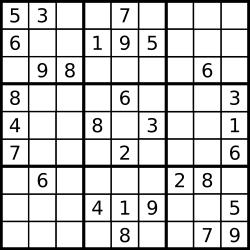36. Valid Sudoku
Determine if a Sudoku is valid, according to: Sudoku Puzzles - The Rules.
The Sudoku board could be partially filled, where empty cells are filled with the character '.'.

A partially filled sudoku which is valid.
Note:
A valid Sudoku board (partially filled) is not necessarily solvable. Only the filled cells need to be validated.
//模拟,就是简单判断下有没有重复
class Solution {
public:
bool isValidSudoku(vector<vector<char>>& board) {
map<char, int> mp;
for(int i = 0; i < 9; i++)
{
mp.clear();
for(int j = 0; j < 9; j++)
{
if(board[i][j] == '.') continue;
mp[board[i][j]]++;
if(mp[board[i][j]] == 2) return false;
}
mp.clear();
for(int j = 0; j < 9; j++)
{
if(board[j][i] == '.') continue;
mp[board[j][i]]++;
if(mp[board[j][i]] == 2) return false;
}
}
for(int i = 0; i < 9; i += 3)
{
for(int j = 0; j < 9; j += 3)
{
mp.clear();
for(int k = i; k < i+3; k++)
{
for(int kk = j; kk < j+3; kk++)
{
if(board[k][kk] == '.') continue;
mp[board[k][kk]]++;
if(mp[board[k][kk]] == 2) return false;
}
}
}
}
return true;
}
};
Write a program to solve a Sudoku puzzle by filling the empty cells.
Empty cells are indicated by the character '.'.
You may assume that there will be only one unique solution.

A sudoku puzzle...

...and its solution numbers marked in red.
//暴力
class Solution {
public:
bool isValidSudoku(vector<vector<char>>& board, int i, int j) {
for(int k = 0; k < 9; k++)
{
if(k == i) continue;
if(board[k][j] == board[i][j]) return false;
}
for(int k = 0; k < 9; k++)
{
if(k == j) continue;
if(board[i][k] == board[i][j]) return false;
}
for(int k = i/3*3; k < i/3*3+3; k++)
{
for(int kk = j/3*3; kk < j/3*3+3; kk++)
{
if(k != i && kk != j && board[k][kk] == board[i][j]) return false;
}
}
return true;
}
bool solveSudoku(vector<vector<char>>& board) {
for(int i = 0; i < 9; i++)
{
for(int j = 0; j < 9; j++)
{
if(board[i][j] == '.')
{
for(int k = 1; k <= 9; k++)
{
board[i][j] = k+'0';
if(isValidSudoku(board, i, j) && solveSudoku(board)) return true;
board[i][j] = '.';
}
return false;
}
}
}
return true;
}
};
The count-and-say sequence is the sequence of integers with the first five terms as following:
1. 1 2. 11 3. 21 4. 1211 5. 111221
1 is read off as "one 1" or 11.
11 is read off as "two 1s" or 21.
21 is read off as "one 2, then one 1" or 1211.
Given an integer n, generate the nth term of the count-and-say sequence.
Note: Each term of the sequence of integers will be represented as a string.
Example 1:
Input: 1 Output: "1"
Example 2:
Input: 4 Output: "1211"
//刚开始没能理解题意,然后看别人博客,原来是统计上一个字符串数字的个数
class Solution {
public:
string countAndSay(int n) {
string s = "1", e;
for(int i = 2; i <= n; i++)
{
int j = 0, len = s.length();
e = "";
while(j < len)
{
int k = j;
while(s[j] == s[k]) k++;
e += k-j+'0';
e += s[j];
j = k;
}
s = e;
}
return s;
}
};Given a set of candidate numbers (C) (without duplicates) and a target number (T), find all unique combinations in C where the candidate numbers sums to T.
The same repeated number may be chosen from C unlimited number of times.
Note:
- All numbers (including target) will be positive integers.
- The solution set must not contain duplicate combinations.
For example, given candidate set [2, 3, 6, 7] and target 7,
A solution set is:
[ [7], [2, 2, 3] ]
//贼暴力的方法。。。
class Solution {
public:
void dfs(int i, int len, vector<int> &nums, int target, int sum, vector<int> x)
{
if(i == len)
{
if(sum == target) ans.push_back(x);
return ;
}
if(sum > target) return ;
dfs(i+1, len, nums, target, sum, x);
for(int j = 1; ; j++)
{
if(target < sum+nums[i]*j) break;
x.push_back(nums[i]);
dfs(i+1, len, nums, target, sum+nums[i]*j, x);
}
}
vector<vector<int>> ans;
vector<vector<int>> combinationSum(vector<int>& candidates, int target) {
vector<int> x;
dfs(0, candidates.size(), candidates, target, 0, x);
return ans;
}
};Given a collection of candidate numbers (C) and a target number (T), find all unique combinations in C where the candidate numbers sums to T.
Each number in C may only be used once in the combination.
Note:
- All numbers (including target) will be positive integers.
- The solution set must not contain duplicate combinations.
For example, given candidate set [10, 1, 2, 7, 6, 1, 5] and target 8,
A solution set is:
[ [1, 7], [1, 2, 5], [2, 6], [1, 1, 6] ]
//详见39题
class Solution {
public:
void dfs(int i, int len, vector<int> &nums, int target, int sum, vector<int> x)
{
if(i == len)
{
if(sum == target) ans.push_back(x);
return ;
}
if(sum > target) return ;
int l = i, r = i;
while(r < len && nums[l] == nums[r]) r++;
dfs(r, len, nums, target, sum, x);
for(int j = 1; j <= r - l; j++)
{
x.push_back(nums[i]);
dfs(r, len, nums, target, sum+nums[i]*j, x);
}
}
vector<vector<int>> ans;
vector<vector<int>> combinationSum2(vector<int>& candidates, int target) {
sort(candidates.begin(), candidates.end());
vector<int> x;
dfs(0, candidates.size(), candidates, target, 0, x);
return ans;
}
};







 本文介绍了Sudoku的有效性验证及求解算法实现,包括通过模拟判断有效性的简单方法和使用递归回溯解决Sudoku谜题的暴力算法。此外,还涉及了计数并叙述序列的生成方法以及组合总和问题的解决方案。
本文介绍了Sudoku的有效性验证及求解算法实现,包括通过模拟判断有效性的简单方法和使用递归回溯解决Sudoku谜题的暴力算法。此外,还涉及了计数并叙述序列的生成方法以及组合总和问题的解决方案。
















 1056
1056

 被折叠的 条评论
为什么被折叠?
被折叠的 条评论
为什么被折叠?








